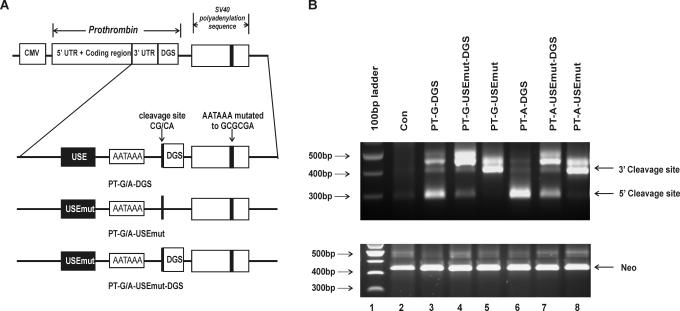Figure 4.
USE in prothrombin 3′-UTR influences the selection of the natural prothrombin cleavage site. (A) Schematic representation of the constructs expressing prothrombin variants. All constructs express the full-length prothrombin cDNA including the entire 3′-UTR under the control of the CMV promoter. Cleavage and polyadenylation elements involved in prothrombin 3′-end formation are indicated: USE, upstream sequence element; DGS, 50 bp downstream genomic sequences; AAUAAA, polyadenylation signal; CG/CA, polymorphic cleavage site. All constructs contain mutations within the SV40 polyadenylation signal (AAUAAA mutated to GCGCGA): PT-G/A-DGS, prothrombin variant cDNA with 50 bp of DGS; PT-G/A-USEmut, prothrombin variant cDNA with mutated USE; PT-G/A-USEmut-DGS, prothrombin variant cDNA with 50 bp DSG and mutated USE. (B) 3′RACE results of RNA prepared from HEK-293 cells transiently transfected with prothrombin allelic variants containing mutations within the SV40 poly A signal, with or without the DGS and/or USE of prothrombin. Lane 1, 100 bp DNA ladder; lane 2, HEK-293 cells transfected with the pCI-Neo vector (con); lane 3: PT-G-DGS; lane 4: PT-G-USEmut-DGS; lane 5, PT-G-USEmut; lane 6, PT-A-DGS; lane 7, PT-A-USEmut-DGS and lane 8, PT-A-USEmut. The 5′ cleavage site represents mRNA produced using the natural prothrombin cleavage site. The slower migrating band (3′ cleavage site) depicts the cryptic downstream cleavage site within the vector sequence. Neo mRNA was used as a measure of transfection efficiency (lower panel).

